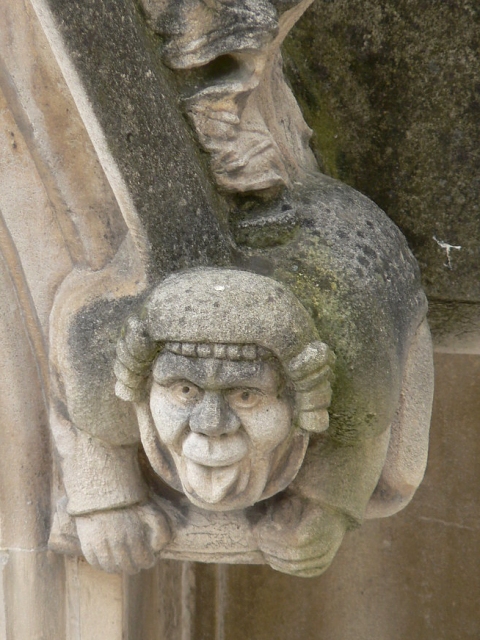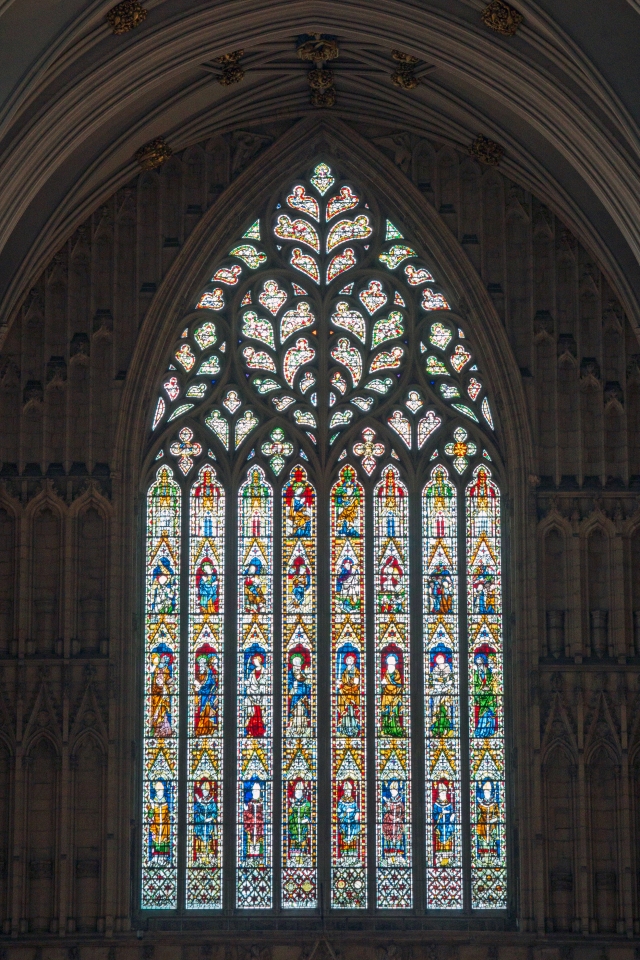
Leaving the church we wind our way through the streets (and growing crowd) toward the Minster. Spirits lightening as brightly as the sky, I zoom in on the gargoyles that I had viewed through a funk the night before. The angst brought about by the ravenous ATM all seems like a bad dream now.
I love gargoyles. I don't know what it is about them, but as far as I'm considered, the uglier and the ruder, the better. For several years I've gone to Barnes and Noble to purchase a gargoyle calendar each January to hang next to my computer desk, my internet bookmarks list is loaded with gargoyle sites; and many years ago gargoyles by exceptionally talented stonecarver Walter Arnold decorated my medieval website.
But these are special gargoyles. They're the first authentic medieval gargoyles I've seen with my own eyes, and I have them captured in my viewfinder.
I've always questioned the fundamental logic behind the premise of gargoyles and grotesques. They were carved on abbeys and cathedrals in medieval times in order to frighten away evil spirits or beings. It seems to me that if an evil being or spirit were to take a good look at these ugly mugs they'd think, "Hey, there's someone just like me. This must be the place!" But I digress.
I would be satisfied to stop right here, and not go into the Minster, but I remind myself of my lack of interest in seeing Castle Howard and how much I'd enjoyed myself there. The entry door is just around the corner and there are more carved faces adorning the archway. After snapping a few quick shots we step into the Minster, which is bustling with activity.
I find myself gaping in awe immediately; the crowds do little to dampen my sense of adventure. I hadn't read up on the Minster before my trip and knew little about it, other than it took over 250 years to build and that it's the largest Gothic cathedral in Northern Europe. I didn't realize that it is renowned for containing the largest collection of medieval stained glass, another one of my passions. I set out to explore this 1,300 year old place of worship, dazzled by my surroundings.
The stone carvings inside impress me as much as the stained glass. I am amazed to think of the time, patience and skill that the artists possessed to create these incredible works. The effigies command my attention, though I am amused by the bored look on the face of one Canon, with a Bible clutched under his arm. "He looks like he wished he'd brought a different book," I say, then look around quickly to see if I've offended anyone with my irreverent humor. Luckily, no one seemed to have heard me.
There are several tours going on and we take advantage of this, surreptitiously joining one, moving along with the group and listening as the guide offers his informative, and sometimes humorous, history of the cathedral. Tiring quickly of formal education, the adventurer in me wanders off to study The Doomstone, a 12th century stone from the Norman Cathedral built by Thomas of Bayeux c. 1080-1100. The stone slab depicts wicked souls being tortured in hell by devils. My fingers itch to touch it, but unlike the Roman maiden at Castle Howard, this stone has a protective barricade around it.

York Minster is the second-largest Gothic cathedral of Northern Europe and clearly charts the development of English Gothic architecture from Early English through to the Perpendicular Period.
The present building was begun in about 1230 and completed in 1472. York is the largest cathedral completed during the Gothic period of architecture.
Read more about York Minster at Wikipedia.

York as a whole, and particularly the minster, have a long tradition of creating beautiful stained glass. Some of the stained glass in York Minster dates back to the 12th century.
The Minster's records show that much of the glass came from Germany. Upon arrival at York, it was intricately painted, fired, then glazed together with lead strips into the windows.
Read more about stained glass in York Minster at Wikipedia.